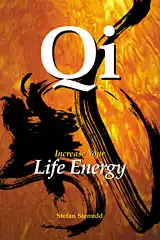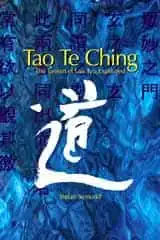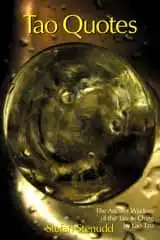|
Tao Te Ching
THE TAOISM OF LAO TZU
|
Tao Te Ching
|
The Book
The Taoism of Lao Tzu Explained. The great Taoist philosophy classic by Lao Tzu translated, and each of the 81 chapters extensively commented. Click the image to see the book at Amazon (paid link). |
Don't Split the Unity
In the second chapter, Lao Tzu continues by presenting a consequence of what he stated in the first chapter. Because the opposites of existence are united in a necessary whole, it's detrimental to separate them – either in deed or in value.
The unity of opposites makes up the world. We should not call one good and the other bad. There is no point in telling them apart at all, since they cannot exist divided. Nor do they make any sense when separated from one another.
Certainly, we appreciate some things more than others, but we must remember that we are able to do so only because we can compare them. The ugly is the mirror of the beautiful. So, who can say that beauty is only within the latter? That's why we are unable to find complete consensus about which is which. What one of us regards as beautiful, another will watch with indifference.
It's even so that each of us changes the way we see things, from moment to moment and from one perspective to the other.
Beauty is no object in itself, but merely the impression of one. It's in the eye of the beholder, and not a fixed quality of that which is beheld. So, we should treat our preferences with the appropriate modesty. And we should learn to appreciate the beauty in the ugly, as well as the ugly in the beautiful. None exists without the other, but within each other.
Good and Bad
We hasten to call some things good and others bad, but fail to recognize that such opposites are also deeply dependent on one another. Judging between them has little meaning. The prickled stem leads up to the flower of the rose. A forest is rejuvenated by fire, as is the soil by the merciless turn of the seasons. Night brings repose from day, and death gives room for new life. One is in need of the other.Even when it comes to human deeds, judging them as good or bad is a risky business for the most experienced judge, as well as for a jury of twelve. There is rarely just one person responsible for a series of events, and within that person there is sure to be a number of contradictions. So, trying to decide on the character of a person in terms of good and bad is even less likely to succeed.
We are more complex than any book can cover. No person is simply good or bad. Both extremes are inside of us, and in a multitude of nuances. Any personality is a mystery beyond explanation. We can only observe the actions by which that personality expresses itself.
What we do is the result of a series of events and reasons. Few of them are at our control. Most of our actions are not ones of choice, but of necessity. We stumble into them, or we are pushed. Certainly, we are still responsible for our deeds, but there is no point in judging them as good or bad. That only interferes with our ability to counteract them when needed, or support them when they are wanted.
Not to mention the problem of what is good for one but bad for another. That's mostly the case. Therefore, modern philosophers prefer to discuss ethics in quantities: what is good for most people, or what is more good for one than it is bad for another, and so on. There is rarely an objective truth to be found, or a value that everyone can share.
Mostly, good and bad are in the hands of those who have power. They decide what is good for all or bad for all. That's usually what happens to be good or bad for them. Lao Tzu has more to say about that attitude, later in the Tao Te Ching.
Deeds of people may force us to react, but we are not helped much by defining those deeds morally, or even deciding on moral standards for all.
We make rules to bring a working order to society and to push society in the direction we want it to develop. We follow these rules when we can, and break them when we cannot constrain ourselves. The rules stipulate what the consequences of breaking them should be. That's all fair and square. There is no need to add a moral judgment to the legal one. For that, we simply do not have enough information.
If we allow morals to influence our judgments, we are unable to be objective. Then there is a risk that the punishment of a deed is far worse than the deed itself.
So, the sage refrains from judging. He is very hesitant to interfere, or to insist that his opinion should be respected. He is reluctant to lead, and refuses to be followed. He is an example without pointing it out.
Since he never puts himself above others, they find no reason to rebuke him.
The Sage
Lao Tzu frequently mentions sheng-jen, which is translated `the sage' in almost every English version of the Tao Te Ching. I spent quite some time pondering alternative translations, but found none better. It implies wisdom of a profound kind. Also, there's an archaic ring to it that fits well with the traditional Chinese idea about ancient times being superior, to which Lao Tzu evidently subscribed.But the sage is not a person elevated above the rest of mankind. To Lao Tzu, anyone can be sage by simply following Tao. Those who do so excel mostly at being humble, not at all separating themselves from their fellow men. The sage is someone like you and me, but he or she has achieved true wisdom. Sheng-jen is a person with a refined spirit, who is modest about his place in the world and shows compassion towards others, whatever the level of their wisdom.
The word sheng is written with a sign that contains three parts: an ear, a mouth, and the sign for a king or sovereign. Someone who listens and speaks beyond the perspective of common men. A refined mind. It's closer to what we call reason than to knowledge. We are reminded of King Salomon of the Bible, who listened carefully to his subjects and then spoke wisely to them. He was a sensible ruler, who knew not to speak before listening. The king commanded according to what he found out from using his ears.
Lao Tzu has little respect for the ones who call themselves learned and clever. Instead, he stresses the superiority of simple reason, what we call common sense. To Lao Tzu, the sage is someone who excels at common sense.
We will learn more about what Lao Tzu regarded as true wisdom in the following. He used the expression sheng-jen more than thirty times in the Tao Te Ching.
The word jen simply means a human being, a person. It's often used like the word `man' is in English. It may refer to a male person, but just as well to human beings of any gender. Lao Tzu certainly had no problem with the possibility of women being truly wise. On the contrary, as will be seen frequently in the following chapters, he tended to regard the female qualities as far superior to the male ones.
He might have expected more women than men to be sage. Actually, what's to say that Lao Tzu wasn't a woman?
The Chinese text rarely specifies gender, either regarding the sage or other characters referred to in the Tao Te Ching. In the English language this would get awkward, so I've had to give it up on several occasions. In such cases I have chosen the male gender, just because the tradition of its use in such a context makes it slightly more neutral than the use of the opposite gender would.
So, please regard any `he' in the text as `he or she.' That's true for my comments as well as for Lao Tzu's chapters.
NEXT
Tao Te Ching Explained
Preface
Introduction
Literature
translated and explained by Stefan Stenudd.
1 |
2 |
3 |
4 |
5 |
6 |
7 |
8 |
9 |
10 |
11 |
12 |
13 |
14 |
15 |
16 |
17 |
18 |
19 |
20 |
21 |
22 |
23 |
24 |
25 |
26 |
27 |
28 |
29 |
30 |
31 |
32 |
33 |
34 |
35 |
36 |
37 |
38 |
39 |
40 |
41 |
42 |
43 |
44 |
45 |
46 |
47 |
48 |
49 |
50 |
51 |
52 |
53 |
54 |
55 |
56 |
57 |
58 |
59 |
60 |
61 |
62 |
63 |
64 |
65 |
66 |
67 |
68 |
69 |
70 |
71 |
72 |
73 |
74 |
75 |
76 |
77 |
78 |
79 |
80 |
81 |
Tao Te Ching Explained
James Legge's Tao Te Ching
Aleister Crowley's Tao Te Ching
The 1st Chapter of Tao Te Ching in 76 Versions
Lao Tzu — Legendary Author of Tao Te Ching
My Taoism BooksClick the image to see the book at Amazon (paid link).
The Taoism of Lao Tzu Explained. The great Taoist philosophy classic by Lao Tzu translated, and each of the 81 chapters extensively commented. |
About Cookies
My Other Websites:
I Ching Online
The 64 hexagrams of the Chinese classic I Ching and what they mean in divination. Try it online for free.
Qi Energy Exercises
The ancient Chinese life energy qi (chi) explained, with simple instructions on how to exercise it.
Life Energy
The many ancient and modern life force beliefs all over the world explained and compared.
Taoismen på svenska
Other Books by Stefan Stenudd
Click the image to see the book at Amazon (paid link).
 Cosmos of the Ancients
Cosmos of the Ancients
The Greek philosophers and what they thought about cosmology, myth, and the gods.
 Qi — Increase Your Life Energy
Qi — Increase Your Life Energy
The life energy qi (also chi or ki) explained, with exercises on how to awaken, increase and use it.
 Aikido Principles
Aikido Principles
Basic concepts of the peaceful martial art. Aikido principles, philosophy, and fundamental ideas.
 Life Energy Encyclopedia
Life Energy Encyclopedia
Qi, prana, spirit, ruach, pneuma, and many other life forces around the world explained and compared.
 Archetypes of Mythology
Archetypes of Mythology
Jungian theories on myth and religion examined, from Carl G. Jung to Jordan B. Peterson.
 Stefan Stenudd
Stefan Stenudd
About me
I'm a Swedish author and aikido instructor. In addition to fiction, I've written books about Taoism and other East Asian traditions. I'm also an historian of ideas, researching ancient thought and mythology. Click the image to get to my personal website.Contact

 Tao Te Ching
Tao Te Ching Tao Quotes
Tao Quotes Fake Lao Tzu Quotes
Fake Lao Tzu Quotes